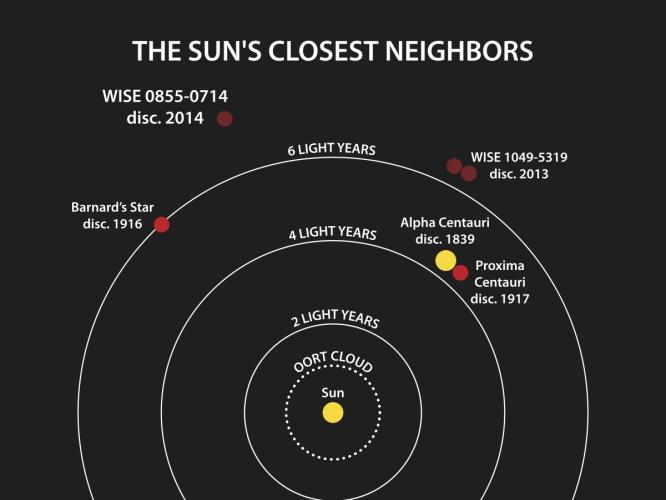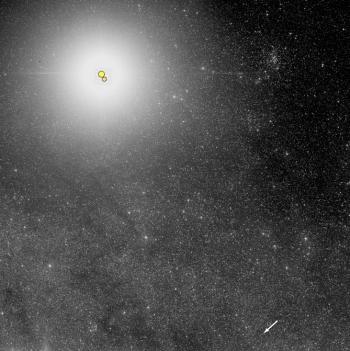
Proxima Centauri is a red dwarf
The star Proxima Centauri isn’t visible to the eye, but it’s one of the most noted stars in the sky. That’s because it’s part of the Alpha Centauri star system, home to three known stars and the closest stellar system to our sun. Of the three stars in Alpha Centauri, scientists believe Proxima is closest to our sun, at 4.22 light-years away. Astronomers have discovered two planets for Proxima so far. It also has massive solar flares and might even be the source of a mysterious radio signal.
Usually, when stars are so close to Earth, they appear bright in our sky. Consider the star Sirius, for example, in the constellation Canis Major. Sirius is the brightest star in Earth’s sky, at just 8.6 light-years away. So why isn’t Proxima Centauri, at 4.22 light years away, even brighter? Instead of being bright, Proxima isn’t visible at all the the eye alone.
And the reason is that Proxima Centauri is so small. It’s what’s called a red dwarf star, one of the most common sorts of stars in our Milky Way galaxy. It contains only about an eighth of our sun’s mass. Faint red Proxima Centauri is only 3,100 Kelvin (5,100 degrees F or 2,800 C) in contrast to 5,778 K for our sun. So Proxima is 500 times less bright than our sun.
Proxima’s location, seen from Earth
Proxima is located in the direction of Centaurus the Centaur, a constellation that’s best spotted from Earth’s Southern Hemisphere. Proxima is nearly a fifth of a light-year from Alpha Centauri A and B. Because it’s so far from the two primary stars, some scientists question whether it’s really part of the star system. The charts below will give you a sense of Proxima’s location with respect to our sun and other stars, and with respect to Alpha Centauri A and B. All of these nearby stars – Proxima, Alpha Centauri A and B, and our sun – orbit together around the center of our Milky Way galaxy.


Planets orbiting Proxima
In 2016, the European Southern Observatory (ESO) announced the discovery of Proxima b, a planet orbiting Proxima Centauri at a distance of roughly 4.7 million miles (7.5 million km) with an orbital period of approximately 11.2 Earth days. Its estimated mass is at least 1.3 times that of the Earth.
Proxima b is within the habitable zone of its star. But a 2017 study suggests that the exoplanet does not have an Earth-like atmosphere.
In June 2020, scientists announced that they had discovered a second planet around the star, Proxima c. This second planet for Proxima is a lot larger than Earth and orbits its star every 1,907 days. It orbits at about 1.5 times the distance from its star than Earth orbits from the sun.
Any planets around Proxima Centauri have to contend with massive flares that pop off the red dwarf, which might or might not spell doom.

Record-breaking flare on Proxima Centauri
Astronomers said in April 2021 that they spotted a flare – or burst of radiation – from Proxima that’s 100 times more powerful than any flare seen from our sun. They said the flare ranks as one of the most violent seen on a solitary star anywhere in the galaxy. Flares like this on Proxima could doom chances for life on its planets.
Astronomer R. O. Parke Loyd of Arizona State University said the verdict for life could go either way. On the one hand, the flares will eventually decimate a planet’s atmosphere. But on the other hand, flares could spark life.
A signal from our nearest neighbor?
Many scientists engaged in the Search for Extraterrestrial Intelligence (SETI) consider the famous Wow! signal to be the best known candidate for an alien radio signal. The 1977 Wow! signal was heard only once. It was never fully confirmed and remains unexplained to this day. But last year scientists found a new possible signal, dubbed by some as Wow! signal 2020. And it appears to come from our nearest neighbor, Proxima Centauri.
The Breakthrough Listen project searching for extraterrestrial intelligence made the detection as part of their study of Proxima Centauri. Read more about this mysterious signal that scientists consider the “most exciting” signal from Breakthrough Listen to date.

Bottom line: Proxima Centauri is the nearest star to our sun at 4.22 light-years away. It’s home to at least 2 planets and massive solar flares.
Enjoying EarthSky so far? Sign up for our free daily newsletter today!
The post Proxima Centauri, closest star to our sun first appeared on EarthSky.
0 Commentaires